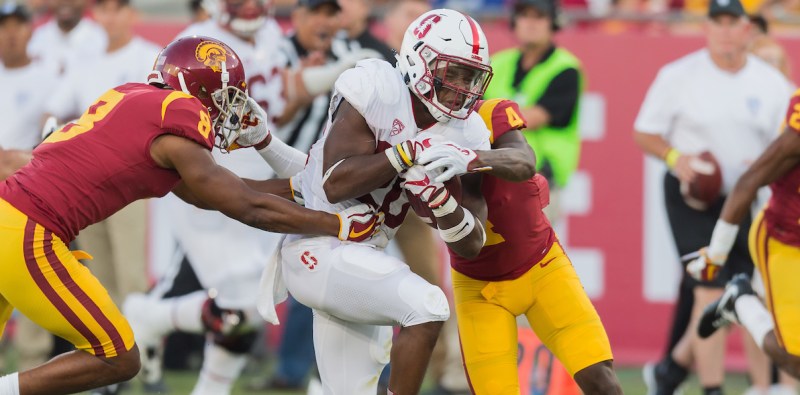Take me back to 2007, please! ESPN, last week, aired enough highlight reel film of Jim Harbaugh and Richard Sherman jumping up and down in pure elation, pulling off the greatest upset in college football history, a forty-one-point underdog, at the Coliseum, to the number two team in the country, yada yada yada, that I almost forgot that this Cardinal team was part of a different reality. In the build-up to the clash at the Coliseum, watching ESPN pundit Desmond Howard declare Stanford is bound for the national title game, possibly to vanquish mighty Alabama, almost made me forget that this Cardinal team was part of a different reality. Remembering that Stanford had defeated USC in three consecutive matchups, and that night two Decembers ago where Christian McCaffrey ran rampant through the SC secondary, almost made me forget that this Cardinal team was part of a different reality. Yet reality crept back quickly in the 2nd half of Saturday’s game, resulting in a 42-24 drubbing at the hands of our Southern California rivals.
Einstein once said that in theory, theory and practice are the same. In practice, they are not. The same is true with Stanford; in abstract, Stanford is solid. The parts should fit together, and make a fairly cohesive team. Yet in actuality, the secondary is rather a mush, pass protection is porous and the rushing defense could barely touch the opposing quarterback if it had a twelve-foot pole. To set the record straight, Stanford is a good team, it might even deserve to be ranked 14th in the country, but it is in no way, shape or form a great team. The Cardinal have too many questions, from a quarterback who may still be recovering from a major injury several months ago, to weak pass protection and pass rush. And the unabatingly conservative play call does not help the situation at all.
The truth is that the dismantling at the hands of USC reveals Stanford’s worst kept secret. It is merely a “regional” powerhouse, for now at least. It occasionally recruits Heisman caliber talent – Andrew Luck, Christian McCaffrey and NFL first rounder’s – Solomon Thomas and Andrus Peat who collectively drive the Cardinal to BCS Bowl games – The Orange Bowl or Rose Bowl, but the consistent inconsistencies in depth at any given position, precludes Stanford from breaking out into that next elite bucket of schools.
Worse yet, Stanford football shows a degree of complacency and attrition. Complacency in play calls – David Shaw is notoriously conservative, and this week’s clash with the Trojans was no exception, with plenty of head scratching calls. If Stanford is to succeed in challenging environments, given its current roster and talent realities, playing the yardage game against Sam Darnold at the Coliseum is just not going to work. And attrition in a loss of talent – from graduations and transfers, but more so a failure to develop talent adequately at a given position. Stanford does recruit top tier players each season, but Shaw’s model has been to cultivate players over multiple years rather than the months that most other programs do. Stanford’s best QB may be sitting on the bench in the form of K.J. Costello.
Make no mistake — Stanford strives for greatness. Its athletic facilities are top notch, and the West Coast offense mimics that of many NFL teams. Yet it seems that here again, in situations where Stanford could break out as a preeminent competitor, not in the Pac-12, but in the national title race, The Cardinal flounders. This year it was at the hands of USC, but there is a familiar pattern. Last year, Stanford collapsed completely against Washington in a high stakes match up. The season before, the Cardinal didn’t show up in the season opener against Northwestern. Having emerged victorious would have undoubtedly laid the foundation for a title run.
Yet seasons past have shown that legacies are not determined in a single loss, but rather by a pattern of reoccurrence. Last year, Stanford would have made it to the Rose Bowl if it had beaten Colorado at home (it lost 10-5). The season prior, Stanford would have gone to the college football playoff if it had beaten Oregon (it lost on a failed two-point conversion). So let this drubbing by USC be a lesson of history, but also one of conviction. Stanford is by no means eliminated from contention to any bowl game, but it does need a significant course correction – one that should start at the helm – if it hopes to advance this season.
In a conference dominated by professional caliber talent at the QB position, Stanford needs to figure out its defensive strategy, and fast. While Sam Darnold did pass for more yards than the speed of most commercial jets, the Cardinal did pick off the USC quarterback twice. Hidden in the jaws of defeat is a glimmer of hope — hope that Stanford soon finds the item it has needed more so than any position, player or coach. It’s the same item that will allow it to finally be more than just a “regional” competitor, rather one that performs on a national stage. That’s consistency.
Contact Michael Spelfogel at mspel ‘at’ stanford.edu.
